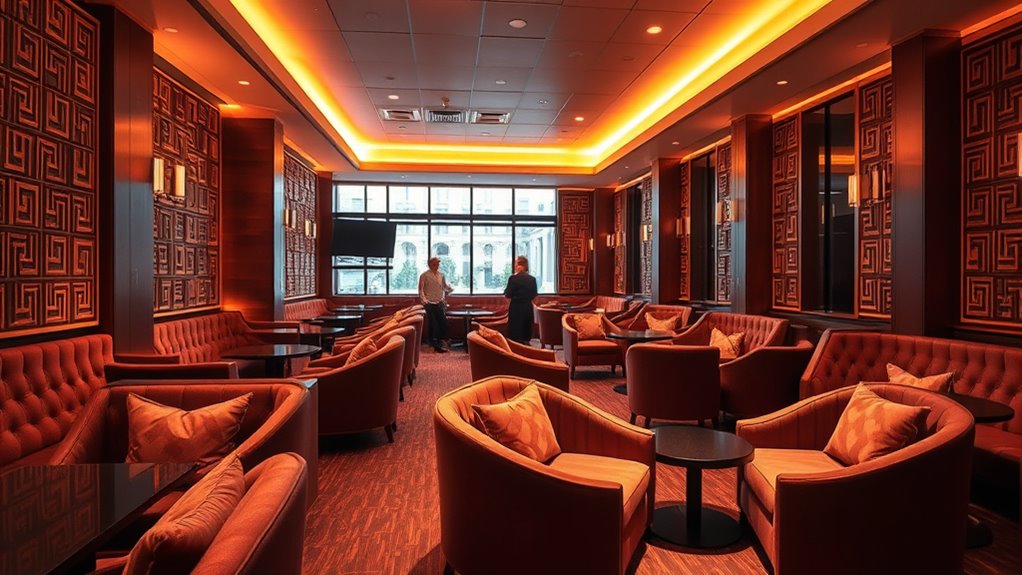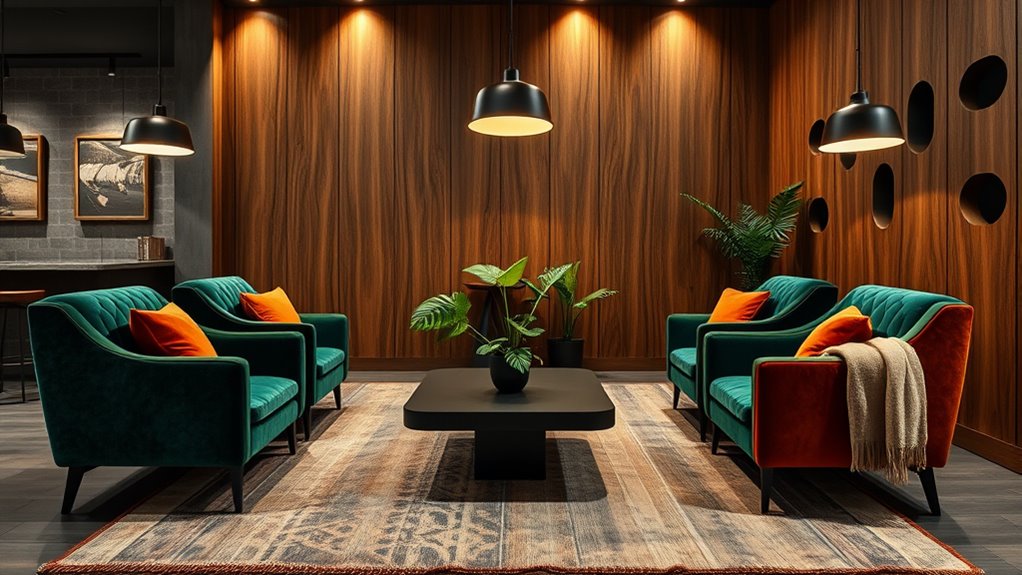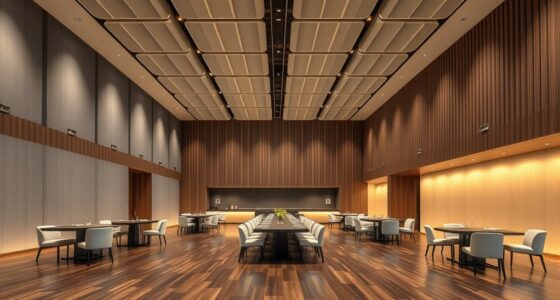To reduce noise without killing the vibe, focus on strategic space planning and using sound-absorbing materials like acoustic panels, soft furnishings, and rugs to dampen echoes. Incorporate barriers and buffer zones to block unwanted sound transfer while maintaining an open, lively atmosphere. Modern tech, such as smart sensors, can help monitor and adjust noise levels in real-time. Want to discover more ways to keep your space vibrant yet quiet? Keep exploring for smarter solutions.
Key Takeaways
- Incorporate soft furnishings like rugs, curtains, and upholstered furniture to absorb sound while maintaining a lively atmosphere.
- Use strategically placed acoustic panels and diffusers to reduce echo without deadening the space’s energy.
- Design space layout with buffer zones and proper room arrangement to minimize unwanted noise transmission.
- Select sound-absorbing materials that blend with decor to enhance aesthetics and acoustic performance simultaneously.
- Implement smart acoustic systems with sensors to dynamically manage noise levels, preserving vibe while controlling excess sound.
Understanding the Balance Between Sound and Atmosphere

Achieving the right balance between sound and atmosphere is essential for creating an enjoyable environment. You want noise levels that energize without overwhelming, ensuring conversations stay clear while maintaining the vibe. Too much sound can drown out music or conversations, making spaces feel chaotic or uncomfortable. Conversely, too little noise might make a space feel dull or empty. To strike this balance, consider how sound influences mood and energy. Think about the purpose of the space—whether it’s lively or relaxed—and adjust your approach accordingly. You need enough acoustic presence to support the atmosphere, but not so much that it hampers comfort or clarity. Understanding this delicate interplay helps you craft spaces that feel vibrant yet controlled, inviting people to stay and enjoy the environment. Incorporating acoustic design principles can further optimize sound levels and enhance overall ambiance.
Sound-Absorbing Materials for Dynamic Spaces

To effectively manage sound levels in dynamic spaces, incorporating sound-absorbing materials can make a significant difference. These materials reduce echo and dampen noise, creating a more comfortable environment without sacrificing energy or vibrancy. Common options include foam panels, acoustic tiles, and fabric-covered panels, which absorb mid to high frequencies effectively. You might also consider mineral wool or fiberglass insulation for larger areas, as they offer excellent sound absorption while maintaining durability. When choosing materials, think about the space’s activity level and how much sound you need to dampen. Properly installed, these materials can help maintain clarity and intimacy in lively environments like restaurants, gyms, or open-plan offices. The goal is to balance noise reduction with the space’s natural energy and vibe. Incorporating sound-absorbing materials can also contribute to better overall acoustics and user comfort.
Strategic Placement of Acoustic Panels and Barriers

Strategic placement of acoustic panels and barriers is essential to maximizing their noise-reducing benefits. You want to position panels where sound reflects and echoes most, like walls, corners, and near loud sources. Barriers can block noise pathways, preventing sound from traveling between spaces. To optimize placement, consider the room’s shape and sound flow. Use the table below as a quick guide:
| Location | Purpose | Tip |
|---|---|---|
| Behind sound sources | Absorbs direct noise | Place close to loud equipment |
| Corners | Reduces echo and reverb | Add bass traps at corners |
| Opposite walls | Deflects sound away or inward | Position to redirect sound |
Proper placement guarantees you reduce noise without sacrificing the vibe. Additionally, understanding environmental considerations helps ensure your setup is sustainable and minimizes impact on the surroundings.
Incorporating Soft Furnishings to Dampen Noise

After optimizing the placement of acoustic panels and barriers, adding soft furnishings can further absorb and diffuse sound, enhancing your space’s acoustics. Incorporate plush sofas, upholstered chairs, and thick curtains to reduce echo and dampen noise levels. Rugs and carpets are also effective, especially on hard floors, as they absorb sound waves and prevent reflections. Throw pillows and fabric wall hangings add extra layers of sound absorption without sacrificing style. By choosing furnishings with soft, dense materials, you create a cozy environment that naturally minimizes background noise. This approach not only improves acoustics but also boosts comfort and aesthetic appeal. Soft furnishings are a simple, flexible way to maintain a lively vibe while controlling unwanted noise.
Leveraging Technology for Real-Time Noise Control

Using smart noise sensors, you can monitor sound levels in real time and identify problem areas instantly. Adaptive sound management systems then adjust acoustics automatically to keep noise in check without disrupting the vibe. This tech makes balancing comfort and energy effortless, giving you control at your fingertips. Additionally, integrating AI-driven sound optimization can further enhance noise control by learning from environmental patterns and user preferences.
Smart Noise Sensors
Have you ever wondered how modern noise control systems respond instantly to changing sound levels? Smart noise sensors make this possible. These devices continuously monitor ambient sound using advanced microphones and digital processing. As soon as noise exceeds acceptable limits, the sensors send real-time data to control systems that adjust sound masking, ventilation, or other noise mitigation tools. This immediate feedback loop helps maintain a comfortable environment without manual intervention. Smart sensors are highly sensitive and can differentiate between various noise sources, ensuring targeted responses. They’re often integrated into building management systems, allowing seamless, automated noise regulation. With these sensors, you get a dynamic, responsive environment that reduces unwanted noise while preserving the vibe you want to enjoy. Additionally, some smart noise sensors incorporate diverse designs to blend seamlessly into different environments, enhancing both functionality and aesthetics.
Adaptive Sound Management
Building on the capabilities of smart noise sensors, adaptive sound management harnesses advanced technology to fine-tune noise control in real time. You can deploy systems that automatically analyze sound levels and adjust speakers or sound barriers instantly, maintaining an ideal acoustic environment. For example, if noise spikes during a busy event, the system reduces loudness or redirects sound to less sensitive areas. Conversely, during quieter moments, it restores volume to preserve the vibe. This dynamic approach ensures you don’t have to manually intervene constantly. Cookies and other data collection methods play a role in optimizing these systems by providing valuable insights. You stay in control of your space’s ambiance without sacrificing comfort or energy. By leveraging machine learning algorithms and real-time feedback, adaptive sound management creates an environment that’s both lively and acoustically balanced, enhancing experiences without intrusive noise.
Design Tips for Maintaining Energy While Managing Noise

Balancing energy and noise control is essential to create an engaging environment without sacrificing comfort. To achieve this, focus on design choices that keep the space lively while dampening excessive noise.
- Use strategic lighting and vibrant decor to energize the space visually, reducing the need for loud sounds to create excitement.
- Incorporate dynamic layouts with open, flexible areas that promote movement and social interaction without amplifying noise levels.
- Select materials that absorb sound but also reflect light and color, maintaining a lively atmosphere without muffling the vibe.
- Regularly assess and adjust your space to ensure an optimal balance between energy and acoustic comfort, applying space management principles to keep the environment lively yet peaceful.
Case Studies of Successful Acoustic Designs

Many successful acoustic designs use innovative soundproof materials to block noise while keeping spaces lively. Strategic space planning also plays a key role in balancing sound absorption and energy flow. Additionally, aesthetic acoustic solutions prove that functionality can go hand-in-hand with style, creating vibrant yet quiet environments. Incorporating natural materials like wood and linen can further enhance both the acoustic performance and the cozy, inviting atmosphere of a space.
Innovative Soundproof Materials
Innovative soundproof materials are transforming how we control noise without sacrificing ambiance. These advanced solutions blend functionality with design, allowing spaces to stay lively while minimizing unwanted sound. For example, eco-friendly acoustic panels made from recycled textiles absorb sound effectively while adding style. Similarly, porous concrete blocks provide durability and noise reduction without bulky installations. Lastly, smart materials like phase-changing gels adapt to sound levels, actively dampening noise when needed. These innovations demonstrate that you don’t have to compromise vibe for silence. Instead, you can create environments that are lively yet peaceful. Incorporating sound absorption techniques into space design enhances both acoustic performance and aesthetic appeal. Embracing these materials empowers you to craft spaces that balance energy and tranquility, proving that soundproofing can be both effective and aesthetically pleasing.
Strategic Space Planning
Strategic space planning plays a crucial role in achieving ideal acoustics, as evidenced by numerous successful designs that prioritize sound management from the outset. When you carefully arrange rooms, consider open versus enclosed spaces, and position noise-sensitive areas thoughtfully, you control sound flow naturally. For example, in a corporate office, separating meeting rooms from high-traffic zones minimizes disruption. In concert halls, optimizing the shape and layout helps distribute sound evenly. You can also incorporate buffer zones, such as hallways or storage rooms, to reduce noise transmission. By integrating sound considerations early, you prevent costly retrofits later. Effective space planning aligns with your goals, ensuring that sound levels support the vibe without compromising functionality. Additionally, understanding how plant health issues can impact environment quality helps create spaces that are both acoustically sound and visually appealing. This proactive approach creates environments that naturally foster better acoustics and more enjoyable experiences.
Aesthetic Acoustic Solutions
Thoughtful space planning sets the foundation for good acoustics, but integrating aesthetic solutions elevates the overall experience. When you choose designs that blend form and function, you create spaces that are both beautiful and quiet. Case studies show that using textured wall panels, decorative diffusers, and stylish acoustic furniture can markedly reduce noise while enhancing your decor. These solutions don’t just improve sound quality—they also reflect your style and personality.
- Visual Harmony: Acoustic panels that complement your interior design make noise control seamless.
- Creative Expression: Artistic diffusers serve as focal points, adding character to your space.
- Functional Style: Stylish furniture with built-in sound absorption balances comfort and quiet.
Frequently Asked Questions
How Can I Measure the Current Noise Levels Accurately?
To measure your current noise levels accurately, you should use a reliable sound level meter or a smartphone app designed for this purpose. Place the device at ear level where you’ll be most affected, and take multiple readings at different times and locations to get an average. Make certain the device is calibrated properly for precise results. This way, you’ll know exactly how loud your space is and can plan accordingly.
What Are Eco-Friendly Options for Soundproofing?
Ever wondered how to soundproof your space without harming the environment? Eco-friendly options include using natural materials like cork, recycled denim, and wool insulation, which absorb sound effectively. You can also opt for biodegradable panels or plants that act as natural sound barriers. These choices not only reduce noise but also promote sustainability. Isn’t it satisfying to create a quieter environment that’s kind to the planet?
Can DIY Acoustic Treatments Be Effective?
Diy acoustic treatments can be quite effective if you choose the right materials and installation methods. You can create sound absorbers using items like blankets, foam panels, or even thick curtains, which help reduce echo and noise. While they might not match professional solutions, these DIY options are budget-friendly and customizable. Just guarantee you place them strategically around your space to maximize noise reduction without sacrificing your vibe.
How Do Weather Conditions Affect Acoustic Performance?
Weather conditions can notably impact acoustic performance. When it’s humid, sound waves may travel differently, causing echoes or muffled audio. Rain and wind can create background noise or disrupt sound clarity, especially outdoors. Cold temperatures can stiffen materials, affecting their sound absorption qualities. You should consider these factors and adjust your acoustic setup accordingly, like sealing gaps or using weather-resistant materials, to maintain ideal sound quality regardless of the weather.
Are There Budget-Friendly Solutions for Large-Scale Spaces?
Imagine you’re the captain steering a ship through a crowded harbor. For large spaces, budget-friendly solutions are like using clever sails—think heavy curtains, movable partitions, or DIY sound-absorbing panels. These options help you navigate noise levels without sinking your vibe. You can also add rugs or plants to soften echoes, making your environment comfortable without breaking the bank. With strategic choices, you keep the space lively and sound-friendly.
Conclusion
So, next time you’re tempted to turn your lively space into a library, remember you can have your cake and eat it too. With the right balance of sound-absorbing tricks and clever design, you’ll keep the vibe alive without turning into a whispering tomb. Think of it like throwing a noisy party where everyone still hears the punchline — loud enough to keep the energy, but not so loud that you’re shouting across the room. Cheers to noise-friendly, vibe-preserving spaces!









